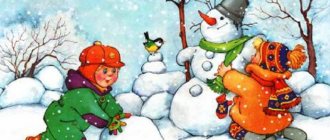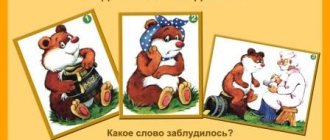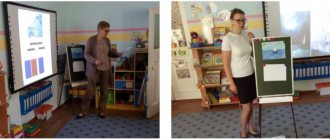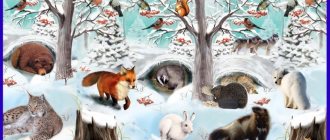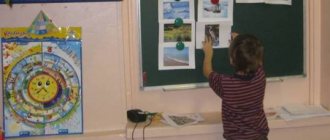Various options for expressing talents
Winter themes are a field for flights of fancy. You can draw a house in the snow, various fantasies about this (snowman, snow queen, Santa Claus), children's games, snowdrifts, animals associated with this season, landscapes (day and night), a river or lake with ice on the surface.
There are many materials for this task: pencils, paints, felt-tip pens, gel pens, cotton wool, glue, glitter.
House in the snow
We present variations of children's drawings on the theme “Winter” with colored pencils and paints. One of them:
To begin, draw three large snowdrifts, one after the other. Draw Christmas trees on them. To do this, draw one stick with a brown pencil. Branches will extend from it. Draw needles on them in green. Draw snow with a white pencil. The house will be hidden behind the snowdrifts. Draw a square and a triangle on top of it. This is a wall with a roof. Place a small square on the wall and a rectangle next to it: a window with a door. Sprinkle the roof with white or blue snow. Ready.
It is better to do the drawing with shading rather than painting over all the empty spaces.
Painting winter with colors:
Here is the first snow and a house in winter. But painting with paints is a difficult task. To begin, make markings with a simple pencil (take the work plan from the first option). Then simply paint with gouache. Indicate snow flakes in blue.
Winter landscape
Winter-winter:
Divide a sheet of paper in half. Place two Christmas trees on the top line, followed by light green birch trees. Distribute as many trees as you think necessary on the sides. There should be snowdrifts in the center. To do this, leave a couple of lines of purple-pink color, shade the blue somewhere.
Winter tree:
We'll have to divide the horizon again. Only now on one third and two thirds of the sheet. In the upper right corner we draw a sun. There are Christmas trees on the horizon line. We will make them blurry, do not draw the outline and details. Using a thin brush, draw two semicircles on the lower part. These are snowdrifts. Using the same thin brush, we draw two birch trees without foliage onto them.
The desired fairy tale
When we hear the phrase “winter fairy tale,” most people think about a snowman, a Snow Maiden, and talking animals.
Therefore, we suggest depicting Christmas trees in the background, and a smiling snowman and his mouse girlfriend in the foreground:
To do this, draw three circles. The bottom one is the largest, the middle one is smaller, and the head is the smallest. She is wearing a red cap and a multi-colored scarf around her neck. There are two twig handles on the side, with warm mittens on them. New Year's gift in hand.
Fairytale winter house:
Nothing new. We combine elements from earlier works: there is a house, Christmas trees, and a snowman. This option is also suitable for children in grades 2 and 3.
Fun
The kids' favorite pastime is, of course, ice skating. Pictures on the theme “Winter fun”:
We draw the upper part of the man the way you are always used to doing it. Spread your legs a little wider than usual. In the second boy, you can depict how he pushes off the ice. The ice should be soft blue, otherwise color as desired.
Mischievous guys love hockey:
We divide the horizon into two parts. The top one is for the sky, trees and gates, the bottom one is for fun activities. How to make a gate: in a gray square, the strokes go diagonally, first from the bottom left to the top right, then from the bottom right to the top left. Place one child on a slide and let the other watch the beautiful picture. Give two children sticks in their hands and throw a black oval puck between them.
We remind you that it is difficult for children to work with paints because they blur on the sheet. The base should be made with a pencil, and blurry spots should be attached to it, symbolizing hair, clothes, and equipment.
Fantasies
Children fantasize and dream most often about gifts, the New Year and Santa Claus. We invite you to draw winter fantasies using sketches:
First, draw an oval, with a smaller oval in its center. We divide the large figure into two parts. We draw a semi-oval on top (and a semicircle on top), and a semicircle on the bottom. We got a hat without a pompom. Hurry up and finish drawing it. The very first oval will contain eyes, furry eyebrows, a nose and a mouth. From the mouth, draw another half circle. Starting from the hat, erase the boundaries, drawing out the beard in detail. Let's paint it over.
Another option:
Draw a circle and a smile in its center. This is the nose of Santa Claus. A luxurious mustache should extend from the nose. Then draw frills on the cap and a full beard in waves. Draw the cap and body, eyes, eyebrows, gifts behind the back. All that remains is to use the paint. Forward! A 4th grade student can easily handle this.
Differences from other seasons
You can often hear children say that if snow has fallen, then winter has already come. But in fact, this symptom occurs both in late autumn and early spring. It is important to emphasize that snow alone does not indicate the onset of winter.
We can talk about a change of season when 5 signs coincide:
- dense, low-hanging clouds, gloomy sky;
- a blanket of snow and ice on the ground and trees;
- short daylight hours;
- hibernation of wildlife;
- appearance of “winter” birds.
We depict nature from the earth to the sky
You can draw winter nature in different ways.
Animals
Who else, if not a bunny, stays awake all winter? What is not a symbol of this time of year:
The steps are extremely simple: draw an oval, not far from it there is a slightly elongated circle. Add the contours of the tail and paws. We connect the head with the body, attach long ears to the head. Add touches to create a wool effect.
Drawing animals with paints is not as difficult as it seems. Penguins live in the ice all year round. They deserve to be in your winter drawing:
How to draw animals: in the upper half we paint the excellent beautiful northern lights. Most of the leaf is occupied by snowdrifts and ice floes. Three little penguins walk happily on them. We make a black oval, slightly tapering at the very beginning. Next to him on the sides are flippers. Dip the brush into orange paint and carefully apply it downwards. These are webbed feet. We paint the eyes and abdomen white.
Forest
Forest - trees and animals collected in one place. How to depict a winter forest in the picture:
How to draw a winter picture with rowan: draw a trunk of medium thickness, short branches extend from it. At their ends we place small red circles in two rows. The first row is longer. Next to the rowan we draw a red semicircle, with two sticks extending from it. There are three more from these sticks: two diagonally, one in the center. Add a black head, beak, wings. Place a couple of Christmas trees and other animals of your choice in the picture. Don't forget to use white and blue pencils to create a snow effect.
Another variant:
First you need to draw the fir trees. Dip the brush into green paint, then press it onto the sheet evenly on both sides. The result is symmetrical needles. We use brown paint to mark the base of the trunk. The rest of it was covered by branches. After that, paint the bottom and top white, leaving space for the moon. We wait for the white paint to dry, then apply pink next to the yellow circle and blue around the edges.
Night
Fairytale night forest:
Even if you work in a minimalist style, there is a chance to achieve the desired recognition. Print the tree in green as in the step above. On top of this layer, apply almost the same, but white, leaving space for the previous one. It turns out to be a Christmas tree that is covered with snow. Add blue paint to the sky and paint stars and snowflakes on it with a thin brush.
River
Drawn picture with a river:
This drawing is also done using shading. Christmas trees are made with blue strokes obliquely and tilted to the right. The sky is in violet-blue tones. Let's add yellow-purple clouds. The river is blue-yellow with a horizontal streak.
What are the 15 signs to recognize winter?
Changes in nature in winter are the most profound and significant. All living things fall asleep, and non-living things freeze, becoming cold and hard.
15 signs that characterize the season:
- cold weather;
- trees without leaves, sometimes with a snow cap on the branches;
- short days and long nights;
- ice crust on puddles, sleet;
- snowdrifts and snow;
- low, gray, heavy clouds;
- bitter frosts;
- blizzard;
- winter fun - ice skating, sledding, snowball fights;
- smoke pours out of the chimneys of houses (in the modern world without stove heating - steam);
- traces of animals and birds in the snow are clearly visible;
- frosty air and steam from the mouth;
- winter holidays - New Year, Christmas, Epiphany;
- an abundance of tits, rooks, crows, the appearance of bullfinches, crossbills and other migratory birds;
- hibernation in insects, fish and some animals (bears, hedgehogs, marmots).
People have long considered frosts to be the first sign of winter, and its end was heralded by the melting of snow. When sub-zero temperatures are established, wildlife falls into suspended animation - trees and shrubs shed their remaining foliage, and fish, insects and individual animals hibernate. Other animals grow a warm undercoat, and the gray hare turns white to blend in with the snow and thus camouflage itself from predators.
Once upon a time, our ancestors gave names to the winter months based on their characteristic features. December used to be called “breasts” - from the word “breasts” or frozen clods of dirt. At the beginning of winter there is still little snow, but the ground has already begun to freeze. Its second name is jelly, from the word icy, cold. January was called the section. It was time to cut down trees. February is characterized by severe frosts, which is why it was called severe.
Making crafts: pleasant gatherings
Winter illustration:
For such a simple craft, we will need a sheet of cardboard, glue, colored and plain paper, and gouache. Cut out a branch from brown paper. We paint snow on it with white gouache. Dip your palm into red paint and press it horizontally to the sheet. All that remains is to add the eyes, beak and legs. Cut out small snowflakes and glue them.
Another simple craft:
Available materials: cardboard, colored paper, cotton wool, cotton pads. Glue the disks on top of each other to make a snowman. We cut out all the necessary details for its decoration from paper. Glue brown tree trunks and a broom onto the leaf. Then we deal only with cotton wool. Tear off small pieces and fluff them up. These will be snowdrifts. Then roll into large balls - this is the crown of the trees. Smaller balls - Christmas tree. The smallest lumps are falling snow.
Works worthy of the competition
We have selected examples of drawings about winter with which your child will be able to win the competition. The implementation techniques were presented above.
For those over ten
Ten-year-old children are old enough to perform more complex techniques for drawing winter. They are already able to work out small details, handle paints so as not to go over the edges.
How to draw pictures on the theme “Winter” for children 10 years old and older:
How to observe changes in nature with children?
To make the story about the distinctive features of winter interesting and memorable for children, it is important to use live examples, visuals, and various game tasks. As the season approaches, it can be helpful to visit familiar places and ask your child what they think has changed:
- How have the trees changed? (bared, foliage disappeared)
- How has the earth changed? (became cold, hard)
- How does the sun warm? (it lights up, but doesn’t heat up)
- What are the clouds like? (gray, low)
- What's missing? (insects, some birds, flowers)
- Have new birds appeared? Which? (yes, bullfinches, redpolls, crossbills, tits, crows, rooks).
- What clothes did you wear here before, and what clothes did you wear now (T-shirts, shorts, and now a jacket, hat, mittens)
It is useful to keep a winter calendar with preschoolers in the preparatory group. Every day you need to note new signs you see. For example, on December 4 the rivers froze, on December 10 snow fell, on December 13 there was ice, on December 17 the child noticed a tit, etc.
The lesson will seem doubly interesting if you talk about folk winter signs, which in the old days were of great importance and passed on from generation to generation. They helped determine what the weather would be like in the spring in order to successfully sow the fields and get a rich harvest.
- A clear day on Christmas Eve (January 6) means a good harvest. The paths are black - buckwheat will be born. The starry sky - a berry year awaits.
- A full month on the night of Epiphany (from January 18 to 19) means a large flood of rivers in the spring.
- Blizzard on January 19 - will occur in 3 months. The day is warm - the bread will be thick.
Beauty - you can't take your eyes off it
Finally, we would like to show you beautiful painted, talented children’s portraits of winter:
We wish you success in all your creative endeavors! Let winter be remembered with a wonderful design.
